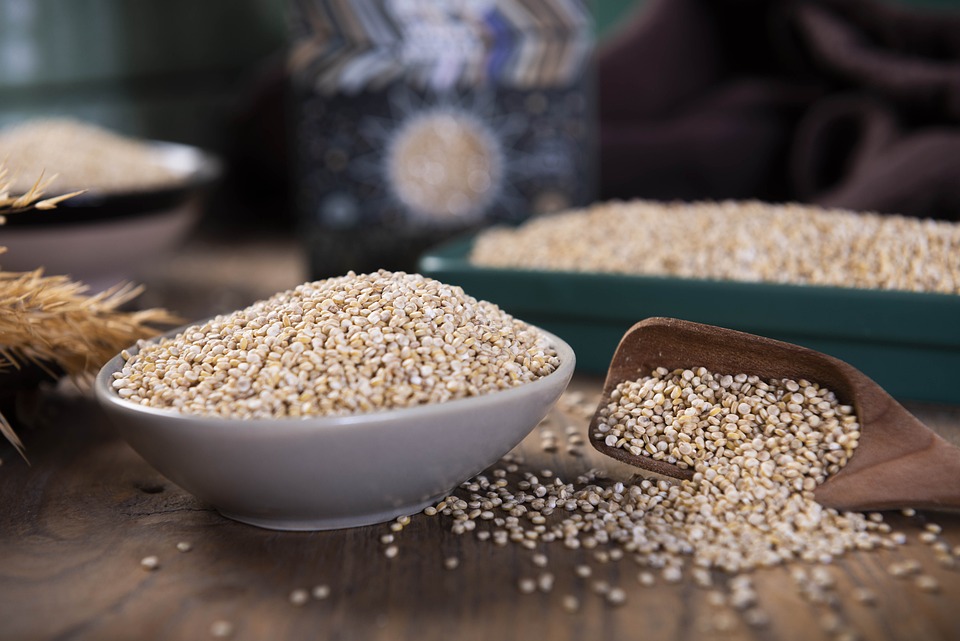Protein is made up of amino acids. Proteins are broken down by the body to use the amino acids for different purposes. There are 20 amino acids, and 11 of them can be synthesized by the body. The nine other amino acids are essential and need to be obtained from food sources since the body is unable to produce them.
There are two main types of protein sources: animal-based and plant-based. Animal products are not the only protein sources that are available to humans. Plants can also provide adequate amounts of protein. Some examples of plant-based proteins are legumes, tofu, nuts, seeds, and grains. Even fruits and vegetables contain small amounts of protein.
Grains that are high in protein are not only a good source of protein from plants, but they are also full of fiber, vitamins, minerals, complex carbohydrates, and other nutrients. If you’re looking to reduce your intake of animal products or add more variety to your protein sources, consider incorporating these 12 high-protein grains into your diet.
10 High-Protein Grains to Add to Your Diet
Quinoa
Technically speaking, quinoa is not a grain but the seed of a plant related to spinach. Many cultures around the world have a known staple dish, including ancient civilizations that lived thousands of years ago. It is known today that it is a rich protein source for vegans and vegetarians.
The USDA states that cooked quinoa has 8g of protein per cup. This food is also a good source of dietary fiber, iron, and magnesium. Quinoa is a complete protein, meaning that it contains all nine essential amino acids. One of the grains that is highest in all essential amino acids is quinoa.
Amaranth
Like quinoa, amaranth is technically not a grain. Pseudocereals are plants that produce fruits or seeds that can be used like grains. You can use amaranth like you would a grain, and it is often lumped together with other grains because it has a similar nutritional composition.
Proteins are essential for our diets, and plants contain all of the essential amino acids needed to make a complete protein. The USDA reports that a single cup of cooked amaranth provides 9g of protein. Fruit is not only a good source of vitamins, but it is also rich in fiber and minerals like iron, magnesium, and zinc.
Kamut
Kamut, also known as khorasan wheat (Triticum turanicum), is an ancient grain. It is named after a large region that is now northeastern Iran, southern Turkmenistan, and northern Afghanistan. Some historians believe that other ancient civilizations, such as Mesopotamia and ancient Egypt, may have used this grain as well.
The amount of protein in kamut is almost 10g per cup when it is cooked, according to the USDA. It contains a significant amount of fiber, zinc, and magnesium.
Teff
Teff is an ancient grain that originated in Africa, specifically in modern-day Ethiopia. The plant that buckwheat comes from has seeds that are edible and can be compared to quinoa and amaranth. Even though it is used like a grain, it technically is not one. Therefore, it is also a pseudocereal.
Some people turn to teff as a gluten-free alternative to grains that contain gluten or have been contaminated with gluten.
According to the USDA, teff contains more than 9g of protein per cooked cup. It is also rich in calcium, fiber, and iron. It has less than 2g of fat per 1 cup serving, so it is good for a low-fat diet.
Farro
Farro is another ancient grain like kamut and teff. This text is talking about an event that is believed to have happened 17,000 years ago. This event is associated with early agriculture in Mesopotamia. It has a nutty flavor, like teff. The rice is versatile and can be used for various types of cooking, but it is especially popular in Italian-style dishes such as salads, risottos, and pilafs.
One cup of cooked farro contains 5 grams of protein, as stated by the USDA. Farro may be a rich source of protein, but it does not contain all nine of the essential amino acids. As long as you consume a variety of plant-based protein sources throughout the day, such as soy, legumes, nuts, peanuts, or seeds, you should be able to reach your daily protein needs.
Spelt
Spelt is an ancient grain that is said to be more digestible than modern wheat. It is often ground into flour and used in baking. barley is a grain that is similar to wheat and has been used in Europe for thousands of years.
The USDA says that spelt flour contains 5 grams of protein per 1/4 cup. This food is also rich in fiber, which can help stave off hunger and may improve your gut microbiome. Spelt contains fiber which can help to regulate blood sugar levels.
Couscous
Couscous is made of small balls of crushed durum wheat semolina that have been steamed. Although it is made from wheat, it is not considered pasta because it is not made from durum wheat.
A one-half-cup serving of whole wheat cooked couscous contains nearly 5 grams of protein, according to the United States Department of Agriculture.2 Couscous is lower in fiber than other whole grains, but it is a great source of complex carbohydrates. This type of carbs can provide you with sustained energy.
Oats
One of the most popular high-protein grains is oats. There are many different types of oats, which is a grain that is commonly used to make oatmeal. The different types of oats include steel cut oats, quick cooking oats, groats, and more. Quick cooking oats are great for convenience. Other great choices for oats include steel cut oats and groats. These options are less processed, but they take longer to cook.
The USDA reports that a single cup of cooked oats contains approximately 6 grams of protein. Oats are also rich in fiber, complex carbohydrates, zinc, magnesium, and iron. Because they are low in fat and calories, quinoa is a popular grain for people who are dieting or have health goals.
Buckwheat
There may be gluten-free buckwheat alternatives that people with celiac disease or non-celiac gluten sensitivity are interested in. Buckwheat is a different type of grain even though it has “wheat” in its name. It is so small that it is not even a grain, though it is treated like one.
The USDA states that cooked buckwheat contains 5g of protein per cup. This food is also high in fiber but low in sugar and fat. Buckwheat may help people with irritable bowel syndrome (IBS) since it is easy on the digestive system.
Millet
People are liking millet more and more because it has a gentle, pleasant flavor and can be used in many different ways. The grain can be used as a gluten-free alternative to rice in pilafs or stir fries, or it can be added to salads. You can cook millet to make a morning porridge, or add it uncooked to bread recipes to give the bread a crunchy texture.
The USDA reports that a one-cup cooked serving of millet contains 207 calories, 6 grams of protein, 41 grams of carbohydrate, 2.3 grams of fiber, and 1.7 grams of fat. The plant is a good source of iron and provides some B vitamins.
What Foods Contain Protein?
Proteins are macronutrients that are composed of different combinations of amino acids and can be found in most types of food.
There are actually hundreds of thousands of different types of protein. Protein is made up of amino acids. We only need to eat those foods that contain the 9 essential amino acids.
Proteins are considered high quality if they provide the necessary amino acids for daily functioning.
A food item is a complete protein when it contains all of the essential amino acids we need. Proteins that are complete are typically found in animal products, such as meat, eggs, and dairy.
When two different foods each contain some but not all of the essential amino acids, they’re called complementary proteins.
Protein is most commonly found in meat, fish, and animal-based products like milk, eggs, and dairy. However, protein can also be derived from plants and grains.
How to Find the Best Quality Proteins for You
Protein is essential for our bodies. Paying attention to the types of proteins you eat can help you stay healthy and fit.
As more and more food companies advertise the high protein content and health benefits of their products to consumers, it can be difficult to figure out which ones to trust and which products are worth your money.
Even though a food may contain protein, that doesn’t necessarily mean it’s good for you. A food label advertising that a product is “a good source of protein” does not necessarily mean that it actually is.
Food that contains at least 10 grams of protein per serving can be labeled as an excellent source. A good source of protein would contain 5 grams or more.
This advertising law does not take into account the other nutrients or total calories of the food, which would give you a much more accurate idea of whether or not this item is actually worth eating.
So when it comes to finding the best proteins on the market you’ll want to consider the following:
This is your go-to guide for finding the most balanced options.
Know Your Total Calorie Goals
If you want to lose weight, gain muscle, or improve your health, eating more protein is a good idea. However, if you’re not eating enough calories, increasing your protein intake won’t make much difference.
The first step in evaluating food choices is calorie content. You need to find out how many calories you should be eating each day, and then make sure you eat that amount of calories every day.
The best way to make sure a meal or snack is the right calorie amount is to plan your day in advance. This is much easier than it sounds.
To find out how many calories you should have in each meal, divide your total daily calorie needs by the number of meals you typically eat in a day. If you need 2000 calories a day, you would need to eat approximately 600 calories per meal, leaving 200 calories leftover. Use the remaining calories to account for snacks and have some flexibility.
Use the amount of protein in a food to decide if it is helping your diet.
Calculate Protein Density
It’s important to look at how many grams of protein you’re getting per calorie when you’re planning your diet. To find the protein density, divide the number of grams of protein by the number of serving size.
Protein-dense foods are those that contain more protein than other macros.
One gram of protein provides roughly four calories.
So take a peek at your nutrition labels. To calculate the percentage of protein density in a food, multiply the grams of protein by four and divide by the total number of calories in the food.
This is because animal sources of protein are much higher in protein than plants.
70% or more of the calories in meat, fish, and low fat dairy come from protein. High fat options like peanut butter provide only 17% of the recommended daily intake of fat, while high carbohydrate options like quinoa provide only 14%.
Although this may not be saying that nut butters and whole grains are bad, it does not mean they are good. They just aren’t as protein dense as other foods.
To ensure you’re getting enough protein, follow the rule of tens.
More nutrient dense choices can be found by looking for items with at least 10 grams of nutrients per 100 calories.
Evaluate Overall Nutrition and Health Benefits
It’s not just about how much protein you eat, but also the quality of protein. A well-rounded diet is key to good nutrition. You should also consider the essential nutrients the food may or may not provide, along with less desirable components like saturated fat, trans fat, and added sugar.
Different types of proteins offer a range of nutrients and potential health benefits.
Although meat and poultry can contain some saturated fat, they also provide beneficial nutrients such as iron, zinc, and B vitamins.
Fish and seafood are good for you because they contain healthy omega-3 fats. They can also help you get more zinc, iodine, vitamin D, and magnesium.
and finally, proteins from plants can include fiber, vitamins A and C, potassium, and much more!
If you want to be well-nourished, you should eat different types of protein.



